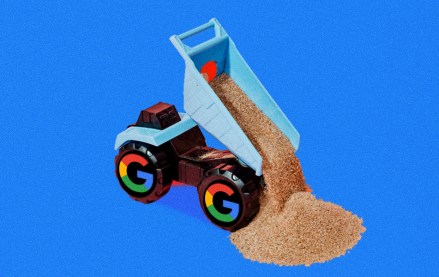How BuzzFeed-backed toy store Camp plans to survive beyond the holiday season
The publisher pop-up shop has turned into a holiday season staple in cities like New York and Los Angeles. Camp, a big retail bet partly owned by BuzzFeed, is hoping to thrive year-round with help from classes and brand activations.
While the 10,000 square-foot New York City toy store, which currently offers 2,500 products ranging from a $2 bouncy ball to a $300 electronic rocking horse, is meant to survive purely as a brick and mortar retailer, it is also banking on brands paying big bucks for activations, which will run anywhere from six to eight weeks. Adding BuzzFeed’s media muscle to the mix helps, but Camp is also designed to reduce the costs that typically make pop-ups so tough for brands.
To make extra money (and build a loyal, local customer base), Camp will play host to classes and activities, aimed at new mothers during the workweek and young children during the weekends.
It’s not clear how much BuzzFeed, which handles media and activation sales for Camp, is charging brands to activate in the store. And it’s not clear how much market demand there is for a space where a brand can sell, either. But retail and agency veterans see in Camp’s structure many opportunities that are hard to come by elsewhere in the market.
“It’s an infrastructural challenge for a brand to justify a real-world, experiential activation on a short-term basis,” said Eric Fleming, the co-founder of experiential agency Makeout. “There’s not many venues that cater to this kind of short-term lease situation.”
Historically, brands have used pop-ups as a way to build buzz or get attention, rather than drive sales. That’s because the economics of spinning up a store on a short-term basis are unfavorable: A short-term sublease in a swanky retail space in Soho, for example, might cost $20,000 per week at the low end, Fleming said.
Throw in costs that might include architects, electricians, fabricators, designers, scenic firms, construction workers, plus staffing for the space itself, and it becomes difficult for even the most successful brands to turn a profit. “It’s very rare for that to be economically viable,” Fleming said.
Camp is set up to minimize those costs. It has existing relationships with fabrication firms in Detroit and New Jersey, as well as in-house designers and consultants who can work on building out activations at a lower cost, Camp founder (and BuzzFeed Commerce head) Ben Kaufman said.
As Camp expands, those up-front costs can be amortized too. Camp will open multiple locations in the United States this year, Camp CMO Tiffany Markovsky Speyer said, though she declined to share specifics about when and where.
As those locations open, brand activations and designs, which are built using concepts borrowed from trade shows, are designed be quickly taken apart and transported to the next location; every design element in Camp’s current setup, which is called Basecamp, can be boxed up and loaded into the back of a single truck, Kaufman said.
To further diversify revenue, Camp’s locations will have regular classes set up for children and their parents. Non-branded classes cost $20-30 per person. Eventually, Kaufman said, Camp may roll out a membership program which would guarantee class admission and an ability to skip the line on busy days.
The idea of Camp changing its stripes regularly follows a concept that’s gaining currency in retail circles, thanks to the buzz generated by stores including Neighborhood Goods, and Story, which was acquired by Macy’s this spring; Story’s founder, Rachel Shechtman, sits on Camp’s board.
Whoever owns most of Camp is making a sizable bet on its success. Its flagship location, 10,000 square-foot retail space, plus a 2,500 square foot basement, is being leased from Loblaw Companies, a Canadian company that owns brands including Joe Fresh. In 2012, Loblaw signed a multi-year lease for the space at 110 Fifth Avenue with a rent price starting at $220 per square foot, according to Compstak data. The asking rent for the sublease Camp signed was $300 per square foot, according to the New York Post. Assuming the ultimate price negotiated falls between those two numbers, Camp would have to pay between $2.75 million and $3.75 million in annual rent.
The activations may have to be a hit, because frequently turning the store over may make it harder to turn customers into regulars.
“Media companies, in theory, have the advantage of knowing people’s habits,” said Steven Dennis, founder of SageBerry Consulting. “But one of the things about remixing your product assortment all the time is, how does the customer understand why they should go to their store?”
Camp expects to use high demand to weather that storm. “In general, repeat customers are very important for most retailers,” Dennis said. “In the toy business, given particular ages, you’re going to birthday parties, you’ve got Christmas, Hanukkah, there’s lots of gift-giving occasions.”
More in Media

AI Briefing: How political startups are helping small political campaigns scale content and ads with AI
With about 100 days until Election Day, politically focused startups see AI as a way to help national and local candidates quickly react to unexpected change.

Media Briefing: Publishers reassess Privacy Sandbox plans following Google’s cookie deprecation reversal
Google’s announcement on Monday to reverse its plans to fully deprecate third-party cookies from its Chrome browser seems to have, in turn, reversed some publishers’ stances on the Privacy Sandbox.

Why Google’s cookie deprecation reversal isn’t actually a reprieve for publishers
Publishers are keeping a “business as usual” approach to testing cookieless alternatives despite Google’s announcement that it won’t be fully deprecating third-party cookies after all.








